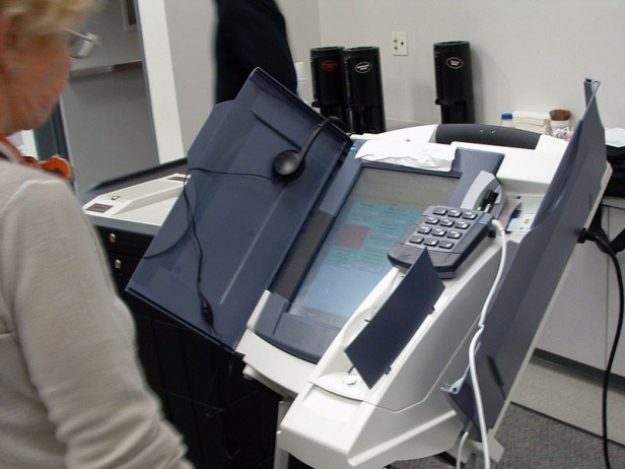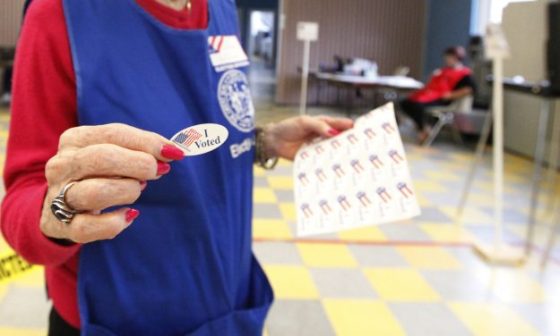Potential voting changes prompt major IT questions in Maine

When Maine voters head to the polls next November, they’ll be deciding more than just who occupies the White House — their choices will determine the future of statewide voting itself.
The certification of a new ballot question last month means voters will get to decide next year whether or not to authorize a new style of elections for Maine known as ranked-choice voting. The proposed system would let voters rank candidates in order of preference, rather than choosing just one candidate in each race.
Advocates for the alternative voting approach say it is badly needed in a state known for its political independence and a multitude of candidates on the ballot. But state IT officials suggest it would come with substantial technological hurdles that would have to be overcome to make ranked-choice voting possible.
Kyle Bailey believes the state needs the new system to help give voters real choice at the ballot box. Bailey is campaign manager for The Committee for Ranked Choice Voting, the group that helped collect tens of thousands of signatures to put the question on the ballot.
“In the rest of the country, third party candidates get single-digit results,” Bailey told StateScoop. “That’s not the case in Maine. Maine has struggled, longer than any other place, with the challenge of multicandidate races with a ballot that’s not designed to accommodate their existence there.”
Bailey claims the benefits of ranked-choice voting are legion, addressing problems as varied as the proliferation of negative campaigning to wilting voter turnout numbers. But it comes with substantial costs.
Julie Flynn, Maine’s deputy secretary of state for elections, has been grappling with the IT implications of the potential change. She estimates, between software upgrades for voting machines, changes to the vote tabulation process and other administrative changes, the state would be forced to shell out roughly $910,00 to get the system off the ground, then about $750,000 each year to keep it running.
The question of whether that expense is worth it will be a key one for Maine voters over the course of the next year, but the issue is hardly straightforward from the backend.
Tech challenges
The more Flynn works to chart a course for ranked-choice voting in Maine, the more problems she sees.
For instance, the state relies on polling workers in roughly 500 separate localities to count votes locally, and then send those results on to the state for verification. Accordingly, making ranked-choice voting a reality can’t just come at the state level, but at individual municipalities.
Flynn’s office expects it would have to upgrade the software on digital tabulators, used to count
votes, in roughly 270 of the state’s towns and other localities in 16 counties. That will cost $25,000 initially, but require additional annual maintenance costs going forward, she said.
“We have to have the software both to lay out the ballot and to have an export of the rankings from each town that uses a tabulator,” Flynn said. “Those results will be saved on a USB drive and we would have to send the state police out there to retrieve those drives,” and bring them back to a central counting location in the state capital of Augusta, in accordance with state law.
For the remaining 230 towns that hand-count votes instead of using digital tabulators, there’s more expense involved. Flynn estimates the state will be on the hook for almost $230,000 in the 2017-2018 fiscal year alone to print new ballots suited for ranked-choice voting.
Once state police collect all the results, Flynn and her office will need to consolidate them,
using aggregation software. But, of course, converting the paper results of the hand-counted ballots into a digital format requires the state to lease high-speed, automatic tabulators at a cost Flynn pegs at roughly $73,000.
Recount hurdles
Flynn notes that the complexity involved in merging the voting results pales in comparison to what the state would go through should a recount be required.
State law requires recounts to be done entirely by hand, a process that already takes an incredibly long time before considering the ranked choice implications.
In testing the process of sorting the ballots by preference, then re-sorting them as candidates were eliminated, Flynn said her staff took roughly two and a half hours just to accurately count 100 ballots, a tiny percentage of the number of votes cast in a statewide race.
“Everybody says ‘Oh it’s going to be simple, it’s simple for the voter, all you’re doing is ranking your choices’ but when you’re trying to explain to them how you would even sort the ballots into piles of stacks of 750,000 ballots in a room…it just boggles the mind,” Flynn said.
Flynn suggests that one solution would be to automate the recount process, but that would require legislative change. Should the ranked-choice provision pass, Bailey expects lawmakers could revisit that very issue, as well as even consider changing the law to allow for the electronic transmission of votes.
Maine boasts “some of the best elections officials in the state,” argues Bailey, who not only contends they are up to the tasks, but also that the costs are well worth ultimate result.
“While that’s not an insignificant amount of money, we think it’s a reasonable amount of money for the upgrades that are required to our technology,” Bailey said.
Maine benefits
But the real benefit is likely to accrue to Maine’s independent nature.
Bailey feels the state has long nursed a rebellious streak in its politics, as evidenced by the election of Maine first Independent governor in 1975.
He notes that the state nearly elected another Independent governor in 2010, when Eliot Cutler finished a close second to current Gov. Paul LePage. That election produced a result where both Cutler and LePage managed to earn less than 40 percent of the vote, just the sort of outcome Bailey hopes ranked-choice voting would prevent, making all the state’s efforts to make the change worthwhile.
“In nine of the last 11 gubernatorial races in Maine, the winner was elected with less than a majority of support,” Bailey said. “This is about ensuring that whomever wins is supported by the broadest coalition of voters.”
The system includes a provision known as an “instant runoff;” if no candidate manages more than 50 percent of the vote, the candidate with the fewest votes is eliminated. Voters who picked that candidate as their top choice have their votes added to the total of their second choice, and the votes are recounted once more until a majority emerges.
Bailey thinks that style of counting would fundamentally change how campaigns are run, making things a bit more civil in the process.
“No longer are you working as a campaign manager to come up with a campaign plan that says ‘How do we win with 35 percent of the vote?’, which is appeal to my base, get them excited, and beat down the opponent,” Bailey said. “The incentives change with ranked choice voting, because you as a candidate don’t just need to appeal for first choice rankings, you may well need second choice and first choice rankings together.”
Any candidate that runs a “slash and burn campaign” risks alienating voters who might otherwise rank them second, Bailey added.
Furthermore, he thinks ranked-choice voting can boost turnout, if people have confidence that their votes are meaningful.
“You never have to worry about your vote being wasted– you get the chance to rank the candidates,” Bailey said.
More civilized campaigns
Politicians and voters have already had a preview of ranked-choice voting in Portland, Maine, where it was used for the last two mayoral elections in 2011 and 2015.
Drew Spencer, legal director for the national ranked-choice advocacy group FairVote, pointed to the experience of city’s first election using the system, and its victor, Michael Brennan.
“In his previous elections [in the state legislature] he’d walk the neighborhoods that were most likely to vote Democratic, and knock on the doors of those voters who he thought would vote for him,” Spencer said. “But under ranked choice voting, he threw out the book, and it became reaching out to as many people as possible.”
Spencer added that his interviews with people in Portland suggested that they had little trouble designing new ballots and making the necessary technological changes to make ranked-choice a reality. Out of more than 20,000 ballots cast, the city invalidated just 32.
FairVote also polled voters to help understand how they felt about the ranked-choice change. In 2011, 94 percent of respondents told surveyors they understood all the instructions and 66 percent called the process “easy.” In 2015, the group recorded similar numbers, with 70 percent of those surveyed describing it as “easy” or “very easy.”
Turnout results mixed
Yet Jason McDaniel, an assistant professor of political science at San Francisco State University, cautioned that his research in other cities shows vastly different results.
McDaniel studied San Francisco’s mayoral elections in 2007 and 2011, which both used the ranked-choice method, and compared them to the city’s elections using a standard format going back to 1995.
His review of exit poll results found that many voters found the new ballot style “more demanding” than others. He believes there was a direct correlation with both an increase in ballot errors and a decrease in voter turnout, particularly among less educated groups.
McDaniel noted that this particularly affected the city’s black and Latino populations, as many lack the same educational opportunities as white or Asian voters.
“I’ve talked to the FairVote people a lot about this, they didn’t like my research,” McDaniel said. “I told them, ‘You can make all kinds of other claims if you want, but if you’re claiming it’s going to increase turnout, my results are not supportive of that.’”
McDaniel does give more credence to the claims elections become more civil during ranked-choice elections, noting that voters perceive less negative campaigning during those contests. But he feels that the losses in voter turnout aren’t worth those gains.
“I’m not so worried about negative campaigning. It’s always been bad to a certain degree,” McDaniel said. “We always sort of have nostalgia for a thing that never really existed, and I think that’s one of them.”
Overall, McDaniel sees the push for ranked-choice voting as the latest in the series of a long line of reforms aimed at making elections better, but that end up having unpredicted negative consequences.
“It’s usually the case that it makes voting harder, which works to the disadvantage of the people who are already the least represented in our system,” McDaniel said.
But for all of McDaniel’s words of caution, Bailey feels the measure has “overwhelming support” in Maine, and ranked-choice voting could very well soon be the law of the land.
If voters do indeed approve it, Spencer thinks Maine won’t be the only state to make the switch.
“The benefits of ranked choice voting are becoming more and more clear all the time,” Spencer said. “If it’s used in Maine, then it becomes ‘the Maine system,’ and it’s an easier lift in that respect.”
Read the second part in StateScoop’s series on ranked-choice voting, examining how states could adopt the new system.





